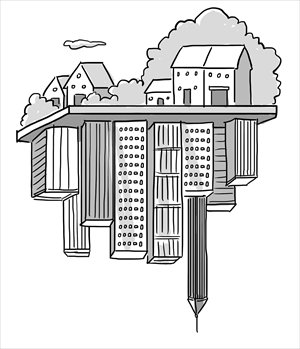Allure of urbanization crosses borders

The big-versus-small debate pervades all facets of our lives. Big may be better, but small is smarter. This seems to be the subtext of a recent "happiness survey" in the Hindustan Times. The happiness index was based on whether people are happy with their health, wealth and sex lives.
The survey's findings are important for what they state as much as for what they conceal. Small is not always beautiful or smart.
The survey shows that smaller cities are the place to make more money, and have better health and a spicier sex life. So, the place where one finds Indian people happy on these counts is not Delhi, Mumbai, Kolkata, Chennai, Bangalore or Hyderabad, but second-tier cities.
It is in Indore, Jaipur and Patna that people are happiest with their health. And, in Ahmedabad, Jaipur and Chandigarh, people are the happiest with the money they possess.
The situation in India is not very different from that which prevails in China when it comes to social mobility and migration driven by economic aspirations.
There is an unending flow of people from the rural areas to the big cities and smaller cities. This demographic churning brings out starkly not only the rural-urban divide in India, but also underscores the tension between big cities and smaller cities now coming to the fore.
The small cities do not mean the satellite cities of larger metropolises. Millions of people from these and other satellite towns constitute Delhi's floating population.
In fact, it is estimated that people commuting daily to Delhi, Mumbai and Kolkata for work could be as high as 20 to 25 percent of the resident population.
They are part of the backbone of the economy sustaining these megacities. Without their labor, goods and services, these metropolises may collapse.
These economically weaker groups, who constitute the bulk of the population, are not reckoned with in the happiness survey.
They are the equivalent of China's migrant labor - tens of millions of them - who build and maintain the cities, its infrastructure, its schools and hospitals, its water and sanitation systems, its stadiums, malls and multiplexes, its transport systems and much else.
Yet, this vast labor majority is deprived of the economic entitlement to cross the threshold of the very survival structures built on their toil.
The majority of these migrants stick to their urban ghettos as they do not have the luxury of choosing between a metropolis and a second-tier city. Sheer survival determines where they live.
While most migrants to the cities are compelled by the urge to escape poverty, there are sometimes other reasons driving them.
In India, many educated young men and women move to the cities to escape discrimination. If the cities are said to be made up of classes, the countryside is made up of castes.
While the cities are not free of caste consciousness, they are more accommodating and tolerant. Pragmatism and productivity dictate that the migrants be treated according to their role at work, regardless of their caste.
The anonymity offered by the city has its advantages for the migrant. He will not be missed if he dies of starvation or is killed by criminals. But, he may also escape being hounded by feuding and feudal elements with political, personal, financial, social or other scores to settle.
Besides, many come to the cities to escape parental pressures and oppressive families.
Above all, dress, manner, demeanor, appearance, abilities, education, networking, and access, depending on opportunity, can make or unmake a person in the big city - or so the migrant believes. The small city mirrors all the fault lines of rural India.
So, if the big city is seething with masses of more migrants than the second-tier cities like Indore and Jaipur, it is because they are cosmopolitan.
Despite the prevalence of parochial tendencies, the general absence of feudal structures, provincialism, caste prejudices and social discrimination that characterize the smaller cities as much as the countryside, make life in the megacities more livable.
The eclectic ambience, relatively speaking, makes for more tolerance, accommodation, humanity and access to opportunities including education and employment.
The poor do not live as objects for sociological study or subjects of happiness surveys.
The fact that the vast majority choose the big cities, which remain a magnet for the multitudes, prove the magical pull of the metropolis.
A metropolis is not only about size, sex, money and health. Were that the case, Hangzhou would have been bigger and more populous than Shanghai.
The author is an independent political, social and foreign affairs commentator based in New Delhi. opinion@globaltimes.com.cn